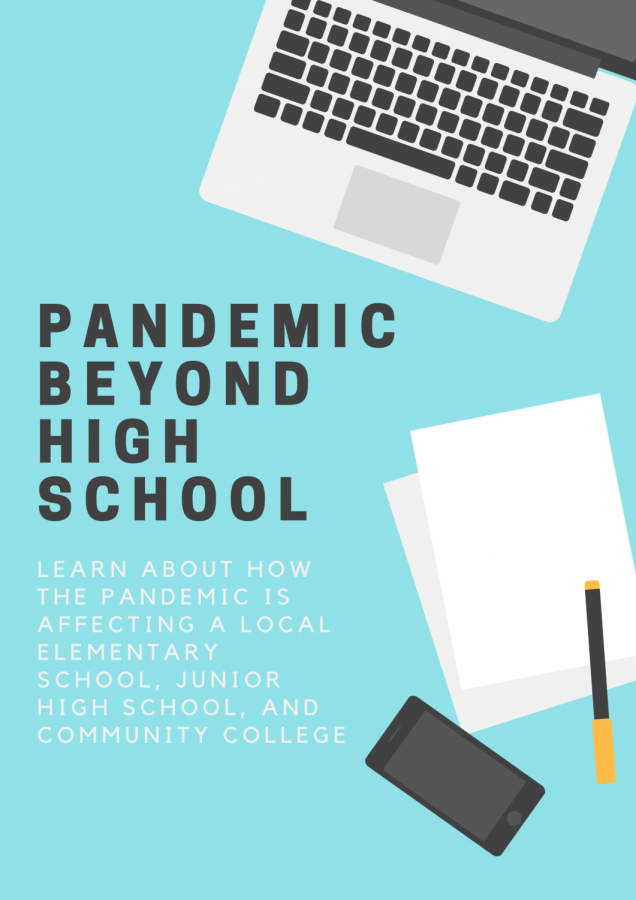Pandemic beyond high school
December 16, 2020
Adjusting to a virtual system of learning has been a difficult and new experience for students and teachers. Beyond West Ranch High School, students and teachers from different grade levels are adapting and learning to use new websites and technologies. Let’s look into specifically how a few local elementary schools, junior high schools, and colleges are operating during the pandemic.
Elementary schools
Elementary school: the easiest yet one of the most fundamental years of your education. The foundation created during these years contributes to forming your first friendships, teacher relationships, and study habits that take you into middle school then high school and for many, college. However, the pandemic has severed the connection between elementary students and teachers and caused everybody to retreat into the world of online distance learning.
From the student perspective, Oak Hills sixth grader Ethan Preach expressed that distance learning has been hard, as “you have to get all your work in on time and attend lots of meets. My teacher doesn’t do recorded lessons so if you don’t make it on time she’ll mark you as late.” Deadlines for homework and the responsibility of remembering the time of each meeting are a few of the many struggles that elementary school students have had to face and figure out from going completely online.
These six years are essential for elementary school students to really explore their first years of education and experience going to school, being in a classroom, and constantly learning new things. With sixth graders like Ethan on the verge of their teenage years and education, going from the classroom scene to a virtual one was a sudden step that took away not only physical learning, but in-person contact with friends, classmates and teachers.
“Getting to play with friends and seeing the teachers in real life” are the little things that Ethan misses from physical school that distance learning can no longer supply. Though both teachers and students are doing their best to adjust and work around this pandemic, Ethan admitted that his teachers are making their best effort to try and accommodate transferring regular schooling to online.
Oak Hills sixth grade teacher Mrs. Huato-Nelson, when asked how she felt as a teacher teaching online, revealed that “it’s not what I signed up for. I think that there’s a lot of potential and that there’s so much to be learned on the platform which is super encouraging.”
Educators like Mrs. Huato-Nelson value the teacher-to-student contact they are able to have in their classrooms before distance learning.
“When I envision teaching, I envision myself being very hands-on,” Mrs. Huato-Nelson voiced. The visual and physical learning that takes place at the elementary school level is not only important to the teachers, but to the students as well because gaining educational experiences does include this type of exposure to young impressionable minds.
To communicate with her students, Mrs. Huato explained, “Through Google Meets and that’s a directive from our district. [Google Meets] ha[s] done a good job in terms of providing things like I really love the breakout rooms and asking the kids questions.” Along with Google Meets, in order to maximize her communication with her students, she uses platforms like Flipgrid (a video submission app), Clever (a larger directive to other homework related websites), and Google Classroom. She even utilizes social media like Snapchat and Instagram to leave pre-recorded messages alongside assignments. Having to diversify the types of platforms Mrs. Huato-Nelson uses in order to get her students attention has been a trial and error process that she is experimenting and learning alongside them.
The pandemic has forced all ages of elementary school students to learn completely online and for teachers to create an online environment adaptable for every student to learn as if in the classroom. The difficulties the elementary school level faces do not differ any greater than at the junior high, highschool and college levels.
Junior high schools
In junior high, students are gaining the necessary skills to succeed in high school. Teachers are preparing students by helping them get used to the harder classes and bigger workload. Due to the current pandemic, junior high students have been unable to go to school in person, meaning they are receiving less guidance and preparation for their years of education to come.
Rancho Pico math teacher Erin McHorney stated that the education of junior high students is necessary because “Jr. High kids are just leaving elementary school and venturing out into a world that lies between the baby days of elementary school and the big kid days of high school.” Junior High is the middle ground between elementary and high school, and there are so many things to figure out, whether it be about yourself, friends, or learning.
The COVID-19 pandemic has put an abrupt stop to in-person learning, forcing the junior high learning environment to shift to online platforms.
“I’m a much worse teacher online, and I fear my students just aren’t learning at the level that I know they could if they were in school,” Mrs. McHorney admits.
The lower levels of understanding among students can be traced to a few key circumstances. One, students learning from home are having a harder time focusing on school and work because the number of distractions at home far outnumbers those at school. Secondly, in-person teachers are able to keep students in the classroom on track to make sure they don’t procrastinate on their assignments. Lastly, online teaching has made it difficult for students to understand all of the material, and the teacher may not be able to help the student in an online format. If school were in-person, teachers would be able to have one-on-one sessions with students to help them learn to their fullest potential.
For junior high students, education isn’t everything. They’re crossing the line from children to teens. The changes that take place at this time can be emotional, physical, and mental. Students need the help of teachers and friends to help them get through these rough years of discovering their identities and their goals.
The switch to online school has been a struggle for teachers and students alike, so the day we can finally go back to school will definitely be an exciting one.
“To feel the physical presence of laughter, and smiles, and eye contact, and just people again will be emotionally overwhelming for me,” Mrs. McHorney stated when asked how she felt about going back to school in person. Undoubtedly, for all of us who have been stuck at home and deprived of social interaction, the day we can go back to school will feel both foreign and familiar, but all the while joyous.
Colleges
During college years, students are preparing for their future, studying for countless hours to gain a degree for a job they want to pursue and building new relationships. However, because of the pandemic, college students are forced to interact with their peers and professors in a virtual setting that is significantly different from the usual college experience. The Paw Print interviewed a student and professor from College of the Canyons to gain insight on how COVID-19 has been affecting them.
Candace Len, a first-year student from COC, explained, “I had to make a stricter schedule for myself since the structure provided by physically going to school is now non-existent.” She adds, “I miss seeing my friends and people in general most. One of the unfortunate things is the eye strain and sedentariness caused by looking at the computer screen all the time.”
With all classes being online, students have to be on screen for many hours attending Zoom and completing assignments through different websites.
“All my professors use Canvas as the platform for communication, my calculus professor uses Webassign for math problems, and the professors for my synchronous classes use Zoom,” Len told The Paw Print.
Biology and environmental science professor Jeannie Chari explained, “I rely on instructor resources from textbook publishers, COC’s library resources and of course information accessed through the web. We have an especially rich and varied catalog of library resources including access to scientific journal articles and documentaries, so I rely heavily on that.”
When asked about how online teaching has affected her, Professor Chari replied, “It was incredibly difficult to move our science labs online. Faculty worked endless hours, and continue to do so. Despite the intensive effort, I don’t think that any of us feel that online is a good substitute for hands on laboratory work. However, we have done our best to provide a valuable experience for students and continue to focus on improvements.”
COC’s staff is working hard to ensure students are having the best learning experience during these tough times.
Once the pandemic is over, Len looks forward to “meeting people the most” since she only interacts with her classmates from her synchronous classes.
Professor Chari expressed her thoughts once school returns back to in-person. “I will be so happy to share space in the classroom with students and have discussions where we can see one another and have a socially dynamic interface. I can’t wait to use the microscopes and experience student’s joy when they discover the incredible diversity that exists in a drop of pond water,” she emphasized.
Students and professors are awaiting for the day when they can finally go back on campus. As of now, they have to remain at home for the sake of their safety and others.
“In the time being, I enjoy hearing my students’ voices over the computer. I enjoy engaging with them during class time and office hours and witnessing their progress and brilliance despite the challenges,” Professor Chari said positively. “Therefore, though I yearn to return to campus, I am also awed and inspired by student resilience and perseverance during these times.”
Elementary schools, junior high schools, and colleges are trying their best to give students a great learning experience in the safety of their homes with the hope that school will soon return back to in-person.




